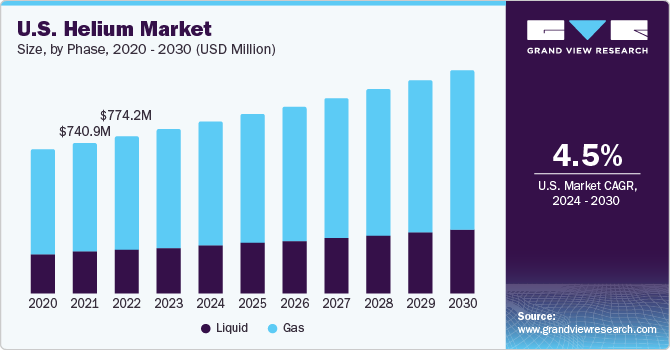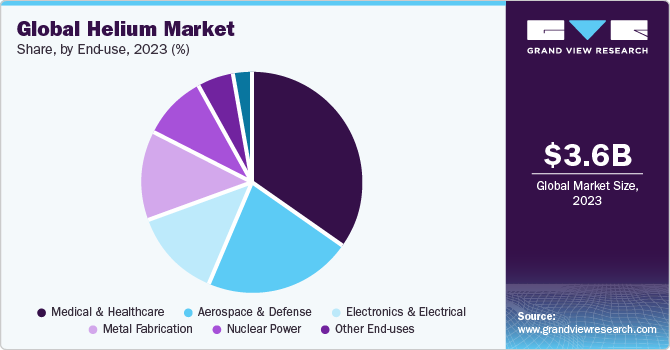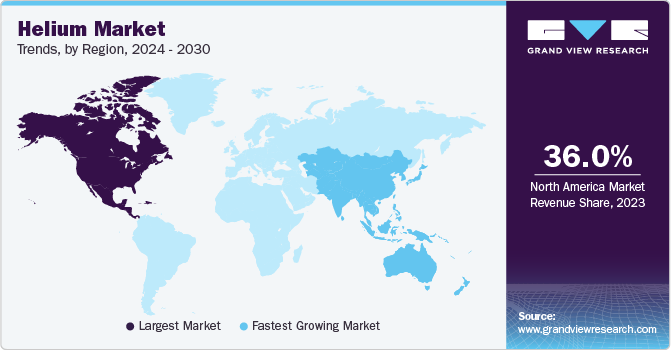- Home
- »
- Petrochemicals
- »
-
Helium Market Size, Share & Growth Analysis Report, 2030GVR Report cover
![Helium Market Size, Share & Trends Report]()
Helium Market Size, Share & Trends Analysis Report By Phase (Liquid, Gas), By Application (Leak Detection, Welding), By End-use, By Region, And Segment Forecasts, 2024 - 2030
- Report ID: GVR-4-68040-164-2
- Number of Report Pages: 150
- Format: PDF, Horizon Databook
- Historical Range: 2018 - 2022
- Forecast Period: 2024 - 2030
- Industry: Bulk Chemicals
Helium Market Size & Trends
The global helium market size was estimated at USD 3,613.2 million in 2023 and is expected to grow at a compound annual growth rate (CAGR) of 6.7% from 2024 to 2030. This is attributed to increasing product usage in numerous end-use industries like aerospace, defense, medical, electronics & electrical, and energy sectors among others. Helium is an essential component in various scientific experiments and research, particularly in fields, such as physics, chemistry, and materials science. As scientific research continues to advance, the product demand remains high. The global industry is experiencing an uptick in competitive activity, with both domestic and international manufacturing firms vying for market share. While multinational corporations hold a substantial portion of the industry, several domestic companies based in nations like Canada, Qatar, Russia, and India are consolidating their presence.

According to the U.S. Department of the Interior, helium ranks as the second most widely available element, following hydrogen. It is an odorless and colorless inert gas, distinguished by its exceptional characteristics. It is considered a finite natural resource, primarily extracted from natural gas reservoirs. The geologic characteristics of regions like Texas, Oklahoma, and Kansas result in some of the highest product concentrations in the world within the natural gas found there, ranging from 0.3 to 2.7 percent. While helium is commonly recognized as a safe, non-flammable gas utilized for inflating balloons, its significance extends far beyond these applications. It serves as a pivotal element in various domains, encompassing scientific research, advanced medical technology, high-precision manufacturing, space exploration, and national defense.
For instance, the medical sector relies on helium for critical diagnostic equipment, notably in MRI machines. In the defense industry, it plays a crucial role in rocket engine testing, scientific balloons, surveillance aircraft, air-to-air missile guidance systems, and numerous other essential applications. The global market exhibits distinctive characteristics in terms of supply, demand, and storage, which have led to a nearly constant escalation in prices. In the past decade, helium demand has remained stagnant, primarily due to limited supply, despite a backdrop of 30% global GDP growth. Unlike the typical relationship between GDP growth and commodity demand, product prices rise each year.
According to AKAP Energy, over the past two decades, helium pricing has displayed a CAGR of 8%, reaching approximately $375 per thousand cubic feet (mcf) by late 2022. This figure is approximately 100 times the current pricing of natural gas in the United States. In recent years, the escalating global helium shortage has emerged as a pressing issue, driven by the diminishing availability of this precious gas. Helium, a rare and invaluable resource, finds utility across diverse sectors including healthcare, electronics, and aerospace. The product supply remains finite and constrained, with its principal source being extraction from natural gas reserves. Concurrently, product demand has been on the rise, propelled by its exceptional attributes, including its remarkably low boiling point, rendering it an ideal choice for a multitude of applications.
End-use Insights
The medical & healthcare segment accounted for a revenue share of 40.00% in 2023. This is attributed to the increasing product usage in various areas of applications in the medical & healthcare sectors, such as MRI machines, endoscopy, laser technology, breathing mixtures, spectroscopy, and in positron emission tomography (PET), among others. Helium-filled aerostats, tethered balloons, or blimps are used for surveillance and monitoring purposes. They provide a stable platform for various payloads, including radar, cameras, and communication equipment, which are used in border security, military surveillance, and disaster management.

Furthermore, it is used in spacecraft as a pressurant gas for propulsion systems, as well as for cooling sensitive equipment and instruments. Its low boiling point and inert nature are advantageous in the vacuum and extreme conditions of space. Product usage in the nuclear power sector is growing, particularly in the development of next-generation nuclear reactors & advanced gas-cooled reactors. Its effectiveness as a coolant and its compatibility with nuclear processes contribute to its extensive usage in this industry. However, product demand, even within this sector, must be managed carefully due to its limited supply. Efforts to secure helium resources & enhance its usage in nuclear power continue to be a priority.
Phase Insights
The gas phase dominated the global market with a revenue share of approximately 72% in 2023. This is attributed to increasing product adoption in various areas of applications including leak detection, gas chromatography, welding & cutting, cooling & refrigeration, and in nuclear power, among others. Furthermore, helium gas is indispensable in the realm of scientific research and experimentation, spanning disciplines, such as physics, chemistry, and materials science. It plays a critical role in cryogenic studies, low-& temperature investigations, and serves as a carrier gas in a multitude of analytical instruments.
Cutting-edge technologies and innovations, like quantum computing and quantum communication, frequently depend on superconducting components that necessitate liquid helium for precise cooling. These emerging technologies play a significant role in the growing requirement for the product. Moreover, it is a finite resource with restricted availability. The majority of global production is derived as a byproduct of natural gas extraction, and not all natural gas reservoirs contain helium. With depleting existing helium reserves and the challenge of finding new sources, product scarcity further fuels its demand.
Regional Insights
North America held a dominant revenue share of 36.00% in 2023 due to the presence of abundant reserves of helium-rich natural gas. In addition, the U.S. is home to the Federal Helium Reserve, which was established in 1925 and is one of the world's largest helium storage facilities. The reserve has played a significant role in the global market by supplying the product to various industries. Europe also holds a significant share, in terms of production as well as consumption of the product from various end-use industries. Europe has a well-established healthcare sector that relies on helium for medical imaging equipment, primarily magnetic resonance imaging (MRI) machines.

It is used to cool the superconducting magnets in MRI scanners, ensuring the stability of magnetic fields and high-quality imaging. The demand for healthcare services & diagnostic imaging drives product consumption in this sector. Asia Pacific serves as a worldwide center for electronics production, with prominent nations including China, Japan, South Korea, and Taiwan leading the semiconductor & electronics sectors. Helium plays a critical role in semiconductor manufacturing, electronics production, and R&D endeavors. Rising demand for consumer electronics and technological advancements are likely to further boost product demand in the electronics industry.
Application Insights
The cryogenics application segment held the largest revenue share of 23.00% in 2023. Helium is one of the few substances that can achieve and maintain extremely low temperatures. It is often used to cool materials and equipment to temperatures close to absolute zero (-273.15°C or -459.67°F), which is essential for various scientific experiments and applications. Furthermore, cryogenic technology is used in space exploration for various purposes, including cooling infrared detectors on telescopes and scientific instruments on spacecraft. It plays a role in maintaining the low temperatures required for these instruments to function effectively.
Helium is an inert, non-flammable, and lighter-than-air gas. Its low density allows objects filled with helium to become buoyant and rise in the Earth's atmosphere. This property makes it an ideal choice for lifting applications. Moreover, it is a safe lifting gas because it does not support combustion. This makes it a preferred choice for applications where safety is paramount, such as in passenger-carrying balloons or airships. Helium is used in various processes within semiconductor manufacturing, such as ion implantation, ion beam milling, and chemical vapor deposition. It helps maintain stable and consistent temperatures during these processes, contributing to the quality and precision of semiconductor devices.
According to the Semiconductor Industry Association (SIA), when examining regional performance, it's notable that the Americas market experienced the most substantial growth, with a 16.2% increase in sales in 2022. China, while remaining the single largest market for semiconductors, reported sales of $180.4 billion in 2022, reflecting a 6.2% decline compared to 2021. In addition, annual sales in Europe and Japan exhibited considerable growth in 2022, with increases of 12.8% and 10.2%, respectively. Thus, a rise in the production and sales of semiconductors increases product demand.
Key Companies & Market Share Insights
The global industry is highly competitive. The majority of manufacturing companies, suppliers, and traders are based in North America and Europe. Rapid industrialization, economic progress, availability of helium-rich reserves, and cheap labor contribute to market growth in these regions. Manufacturers are undertaking various strategic initiatives, such as mergers & acquisitions, partnerships, collaborations, production capacity expansions, and new product launches, to strengthen their market share.
For instance, in October 2023, North America Helium (NAH) announced its seventh facility into production. This facility is located in Cadillac, near Ponteix, Saskatchewan. The upcoming facility will commence with an initial helium production capacity of 22 million cubic feet per year (MMcf/year). Owing to ongoing drilling achievements in the region, NAH is already in the process of devising expansion plans for this facility in 2024.
Key Helium Companies:
- Air Products and Chemicals, Inc.
- Linde Plc
- Air Liquide
- Messer Group
- Taiyo Nippon Sanso India
- MESA Specialty Gases & Equipment
- Matheson Tri-Gas Inc.
- Iwatani Corporation
- Gazprom PJSC
- Gulf Cryo S.A.L.
- IACX Energy
Helium Market Report Scope
Report Attribute
Details
Market size value in 2024
USD 3,852.33 million
Revenue forecast in 2030
USD 6.07 billion
Growth rate
CAGR of 6.7% from 2024 to 2030
Base year for estimation
2023
Historical data
2018 - 2022
Forecast period
2024 - 2030
Quantitative units
Volume in kilotons, Revenue in USD million/billion, and CAGR from 2024 to 2030
Report coverage
Volume and revenue forecast, company ranking, competitive landscape, growth factors, and trends
Segments covered
Phase, application, end-use, region
Regional scope
North America; Europe; Asia Pacific; Central & South America; Middle East & Africa
Key companies profiled
Air Products & Chemicals, Inc.; Linde Plc; Air Liquide; Messer Group; Taiyo Nippon Sanso India; MESA Specialty Gases & Equipment; Matheson Tri-Gas Inc.; Iwatani Corp.; Gazprom PJSC; Gulf Cryo SAL; IACX Energy
Customization scope
Free report customization (equivalent up to 8 analysts working days) with purchase. Addition or alteration to country, regional & segment scope
Pricing and purchase options
Avail customized purchase options to meet your exact research needs. Explore purchase options
Global Helium Market Report Segmentation
This report forecasts volume and revenue growth at global, regional, and country levels and provides an analysis of the latest trends in each of the sub-segments from 2018 to 2030. For this study, Grand View Research has segmented the helium market report on the basis of phase, application, end-use, and region:

-
Phase Outlook (Volume, Kilotons; Revenue, USD Million, 2018 - 2030)
-
Gas
-
Liquid
-
-
Application Outlook (Volume, Kilotons; Revenue, USD Million, 2018 - 2030)
-
Breathing Mixes
-
Cryogenics
-
Leak Detection
-
Pressurizing & Puring
-
Welding
-
Controlled Atmosphere
-
Other Applications
-
-
End-use Outlook (Volume, Kilotons; Revenue, USD Million, 2018 - 2030)
-
Aerospace & Defense
-
Medical & Healthcare
-
Electronics & Electrical
-
Nuclear Power
-
Metal Fabrication
-
Other End-uses
-
-
Regional Outlook (Volume, Kilotons; Revenue, USD Million, 2018 - 2030)
-
North America
-
U.S.
-
Canada
-
Mexico
-
-
Europe
-
Germany
-
UK
-
France
-
Italy
-
Spain
-
Poland
-
Russia
-
-
Asia Pacific
-
China
-
India
-
Japan
-
South Korea
-
Australia
-
-
Central & South America
-
Brazil
-
Argentina
-
-
Middle East & Africa
-
Saudi Arabia
-
South Africa
-
Qatar
-
Algeria
-
-
Frequently Asked Questions About This Report
b. The global helium market size was estimated at USD 3,613.2 million in 2023 and is expected to reach USD 3,852.33 million in 2024.
b. The global helium market is expected to grow at a compound annual growth rate of 6.7% from 2024 to 2030 to reach USD 6.07 billion by 2030.
b. North America dominated the global helium market with a share of 36.0% in 2023. This is attributable to the presence of abundant reserves of helium-rich natural gas.
b. Some key players operating in the global helium market include Air Products and Chemicals, Inc., Linde Plc, Air Liquide, Messer Group, Taiyo Nippon Sanso India, and MESA Specialty Gases & Equipment, among others.
b. Helium is an essential component in various scientific experiments and research, particularly in fields such as physics, chemistry, and materials science. As scientific research continues to advance, the demand for the product remains high.
Share this report with your colleague or friend.
![gvr icn]()
NEED A CUSTOM REPORT?
We can customize every report - free of charge - including purchasing stand-alone sections or country-level reports, as well as offer affordable discounts for start-ups & universities. Contact us now
![Certified Icon]()
We are GDPR and CCPA compliant! Your transaction & personal information is safe and secure. For more details, please read our privacy policy.
We are committed towards customer satisfaction, and quality service.
"The quality of research they have done for us has been excellent."





